Influencer Marketing Statistics (How Many Influencers Are There?)
Are you ready to closely examine influencer marketing statistics and see how powerful it is?
In the world of digital marketing (have you seen our digital marketing statistics?), one strategy has taken center stage and revolutionized how brands and businesses connect with their target audiences – influencer marketing.
With the rise of social media and influential personalities across all industries and niches, this innovative approach has become part of almost every brand’s success.
Join us as we explore influencer marketing by ROI, engagement, reach, social media platforms, and challenges – and even look at fraud. + some more!
This article equips you with the knowledge and statistics needed whether you’re an ambitious influencer trying to understand the industry or a brand looking to leverage the potential of influencer marketing.
Enter this exciting and influential space now.
This post covers:
Influencer Marketing Statistics (Our Top Picks)
- There are more than 30 million influencers in the world
- More than 1 in 4 marketers leverage the power of influencer marketing
- 88% of people seek authenticity in influencers
- Mega-influencers can earn $1,000,000 per IG post
- 60% of marketers say influencer-generated content generated more engagement than branded
- 54% of brands that work with influencers run eCommerce stores
- Micro-influencers have a 60% better engagement rate than macro-influencers
- Instagram is the most preferred influencer marketing platform
- Nearly 60% of YouTube viewers are male
- 72% of TikTok users say they relate to non-celebrity creators more than celebrity ones
- 60% of Facebook video views are from influencer videos
- 55% of businesses have experienced influencer fraud
How Many Influencers Are There?
1. There are more than 30 million influencers in the world
Unfortunately, different sources have different numbers of the total influencers there are in the world. Some say there are over 30 million, while another reports 50 million.
On the other hand, SocialStar has the information that there are 10+ million influencers globally.
Source: EarthWeb, SocialStar
2. There are 22% of Instagram influencers with 20K to 100K followers
Instagram is one of the most popular platforms for influencer marketing at the time of writing this. When looking at influencers by the number of followers, the most significant chunk of them have between 5,000 and 20,000 followers.
| Number of followers | Share of influencers |
| 1,000 – 5,000 | 27.9%% |
| 5,000 -20,000 | 44.1%% |
| 20,000 -100,000 | 22.7%% |
| 100,000 – 1,000,000 | 5.0% |
| 1,000,000+ | 0.3% |
The largest IG celebrity influencers are Cristiano Ronaldo, Lionel Messi, Kyle Jenner, Selena Gomez and Dwayne “The Rock” Johnson.
Source: Statista #1
3. TikTok had 106K influencers in 2020
The newest stat on the number of TikTok influencers we could find is from 2020, revealing that the platform had over 106,000 influencers. The number grew by 35,500 from 2019.
But there are likely way many influencers on TikTok today because of how fast the platform is growing.
Source: Statista #2
4. There are over 50% of YouTube influencers with fewer than 15K subscribers
The largest group of YouTube followers are those with less than 15,000 subscribers, 51.37%. The second largest group is influencers with 100,000 to 500,000 subscribers (16.43%), and the third is channels with 15,000 to 50,000 subscribers (11.84%).
Source: Statista #3
5. Cristiano Ronaldo has 163 million Facebook followers
And that makes Cristiano the largest celebrity influencer on Facebook, followed by Shakira (123 million followers), Will Smith (115 million followers), Leo Mesi (144 million followers) and Vin Diesel (106 million followers).
Source: Facebook
Influencer Marketing Industry Statistics
6. The influencer marketing market has more than doubled since 2019
The influencer marketing industry is spreading like wildfire. In 2023, it’s valued at a whopping $21.1 billion, with the largest country-wise share having the United States.
Source: Statista #4
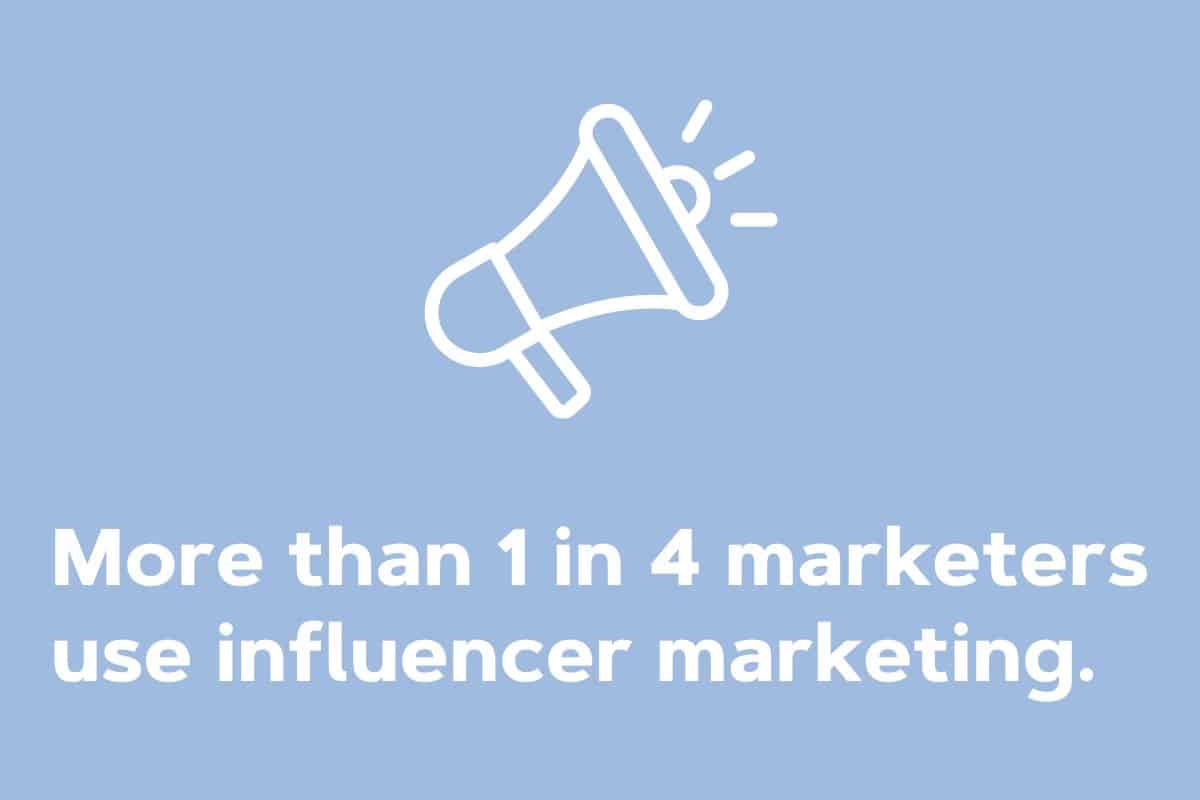
7. More than 1 in 4 marketers leverage the power of influencer marketing
With one of the best marketing channels when it comes to return on investment, it’s no wonder why more than one in four marketers leverage the power of influencer marketing.
Moreover, in 2023, 17% of marketers plan to invest in it for the first time and nearly 90% of those already using it will maintain or increase their investments.
Source: HubSpot
8. 72% of Gen Z and Millennials follow influencers on social media
A considerable percentage of Gen Z and Millennials follow influencers on their favorite social media platforms, with teenagers being more likely to follow them than the older generation.
Fun fact: Gen Z treats top YouTube influencers as popular as major celebrities. Yes, they value PewDiePie and Lebron James equally.
Have you ever wondered how many people use social media? Our social media statistics reveal it all.
Source: Morning Consult
9. 88% of people seek authenticity in influencers
One of the leading traits followers seek in influencers is authenticity and being genuine, according to nearly 90% of respondents.
Source: Morning Consult
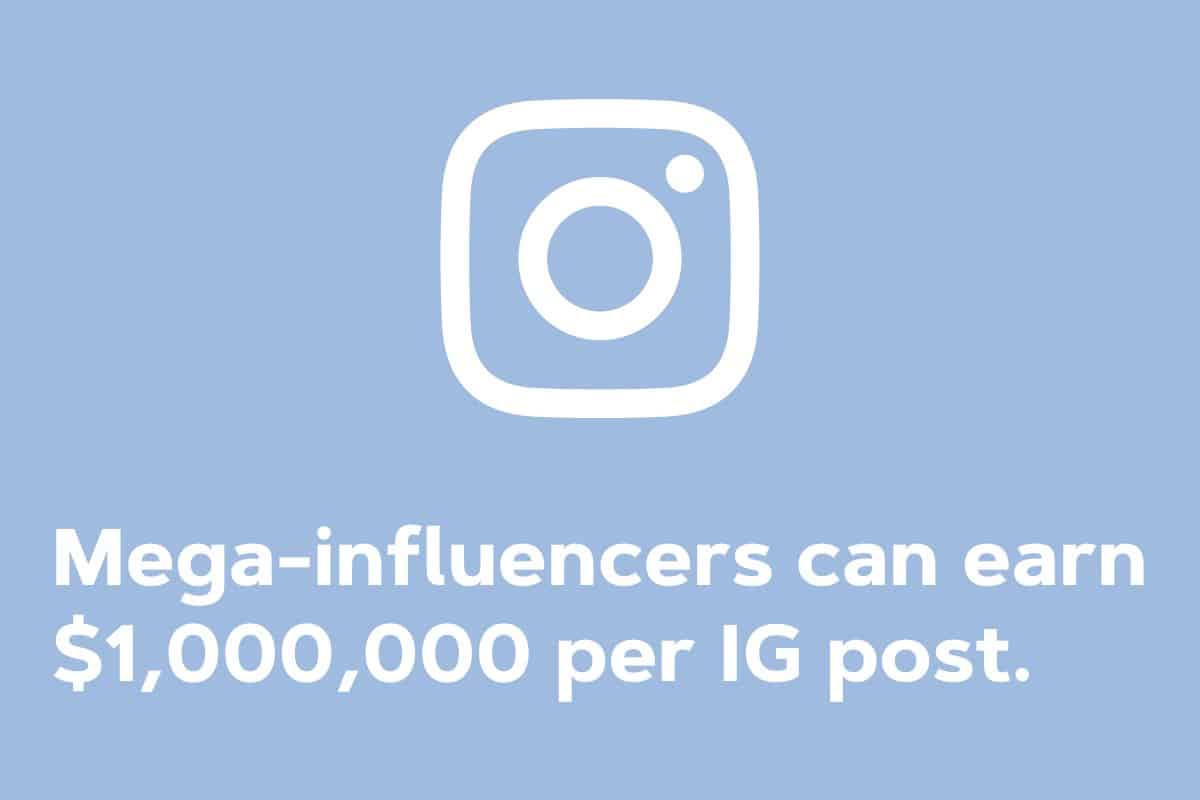
10. Mega-influencers can earn $1,000,000 per IG post
While the following numbers can vary drastically per influencer type/size, they’re a great reference if you’re new to the space:
- Nano-influencers can earn $10- $100 per post
- Micro-influencers can earn $100- $500 per post
- Mid-tier-influencers can earn $500- $5,000 per post
- Macro-influencers can earn $5,000- $10,000 per post
- Mega-influencers can earn $10,000+ per post
Remember, many factors contribute to the pricing – meaning, a macro-influencer can earn a lot more than the average estimate or even a lot less. But use the numbers above as a starting point.
Source: Andrew Macarthy
Influencer Marketing ROI Statistics
11. Influencer Marketing has the second-highest ROI of any trend
Across five different marketing channels, influencer marketing scored the second highest, with an average ROI of 7%. Only short-form video content (TikTok, Facebook/Instagram Reels, YouTube Shorts, etc.) surpasses it with an ROI of 10%.
Source: HubSpot
12. 38% of marketers’ goal for influencer marketing is sales
In a 2022 survey, 38% of marketers picked “generating sales” as their primary goal for influencer marketing. The second most common goal was brand awareness (29%) and the third was brand engagement (24%).
Speaking of sales, check these extensive sales statistics and learn the sales success rate (and more!).
Source: Statista #5
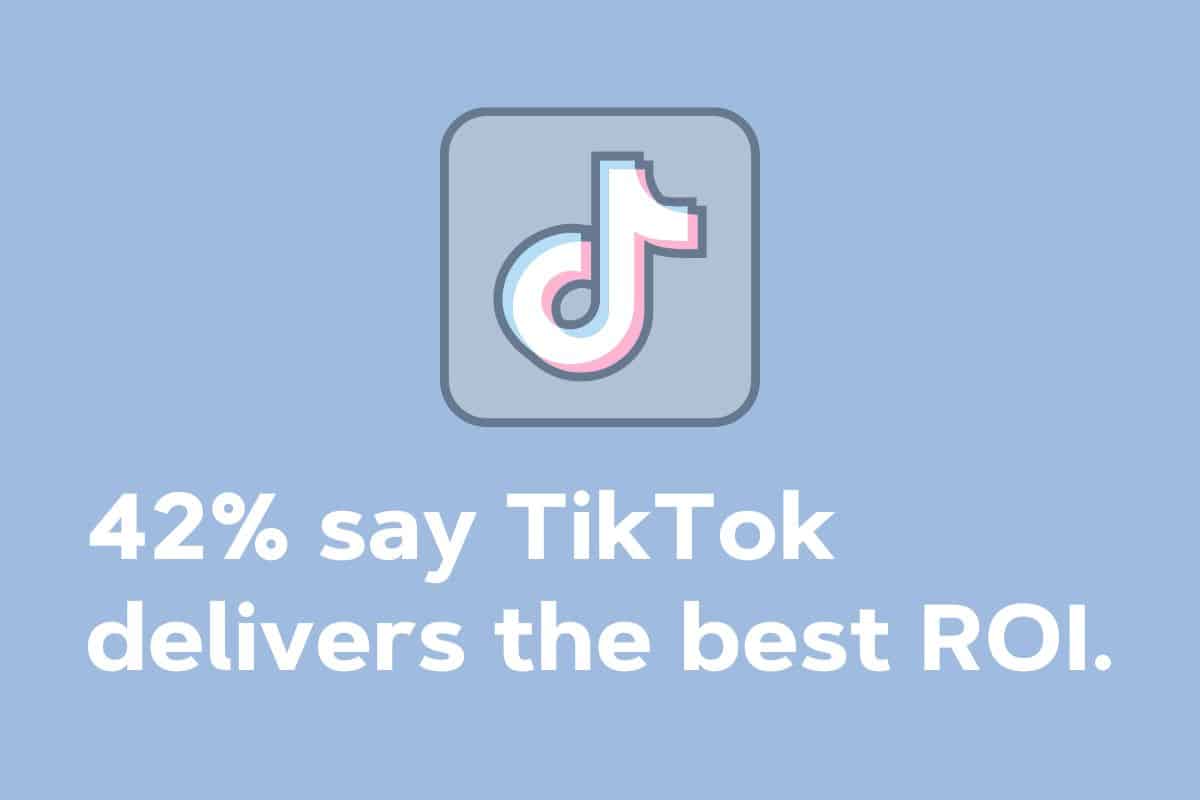
13. 42% say TikTok delivers the best ROI
Since Influencer Marketing Hub didn’t include Facebook Reels in their survey, we cannot say which channel generates the best ROI (it might just be Reels).
Anyway, 42% of their respondents picked TikTok as the best ROI generator, followed by Instagram Reels (34%), YouTbe Shorts (19%) and Snapchat (6%).
Source: Influencer Marketing Hub #1
14. Over 70% of marketers measure the ROI of their influencer marketing efforts
Let’s first mention that 74% of brands/marketers track sales from their influencer marketing campaigns. Knowing this, it’s no surprise that 71% of them also measure the ROI, which is up by 1% since 2022 and up by 6% since 2020.
Although the percentage of businesses that measure ROI is pretty high, it still surprises me that around 30% of them don’t “care” about ROI.
Source: Influencer Marketing Hub #1
15. 83% consider Earned Media Value as a good ROI measure
Less than 20% will agree that Earned Media Value (EMV) isn’t a good measure of ROI. However, it’s also worth mentioning that those against using EMV either don’t understand it or struggle to communicate its worth.
Note: Earned Media Value is an influencer marketing metric that calculates the value of social media content (engagement).
Source: Influencer Marketing Hub #1
Influencer Marketing Engagement & Reach Statistics
16. Views/reach/impressions are the most important criteria when assessing influencers
How to pick a good influencer to work with?
35% of Influencer Marketing Hub respondents said they consider views, reach and impressions as the most important criteria. 19% chose content type and category, 18% sales and 17% engagement/clicks. Interestingly, the latter was the most important criterion last year but saw a significant decrease in 2023.
Source: Influencer Marketing Hub #1
17. Views, reach and impressions are the most common measures of influencer marketing success
Similar to assessing influencers, businesses and marketers also use views, reach and impressions to measure their influencer marketing success. Nearly 50% of them do!
The rest are split into 1) 25% use engagement or clicks, and 2) 25% use conversions or sales.
Source: Influencer Marketing Hub #1
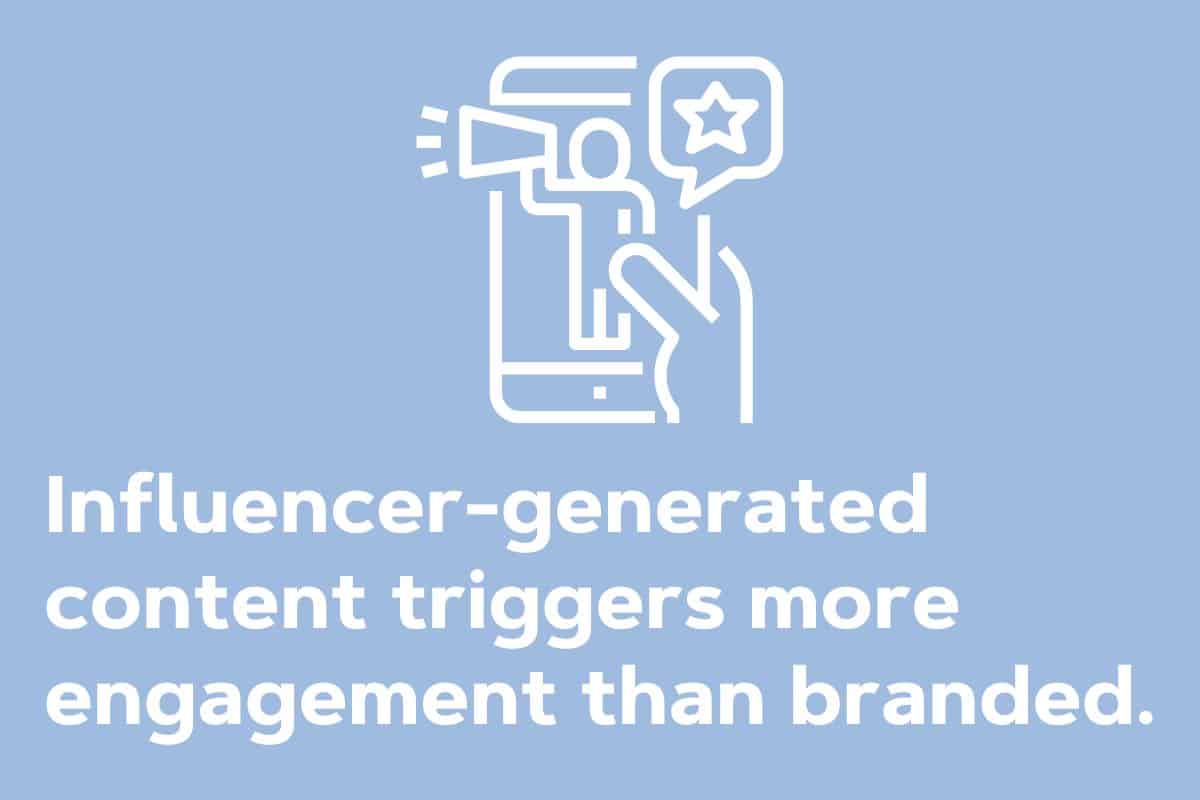
18. 60% of marketers say influencer-generated content generated more engagement than branded
I’ve seen influencers often mention they refused the offer from brands who told them exactly how the product or service needs to be advertised. Why not just let the influencer do his/her thing? Hey, they know their audience the best.
And according to 60% of marketers, influencer-generated content performs way better in terms of reach and engagement than branded posts.
Source: Influencer Marketing Hub #2
19. Influencers with 10K-100K followers have the best combination of engagement and reach
Usually, smaller influencers’ posts perform better than larger ones (which you will learn below).
But what size profiles have the best combination of engagement and broad reach? The mid-tier influencers with anywhere from 10,000 to 100,000 followers.
And that’s why these are probably the ideal influencers you should focus on when entering the influencer marketing game.
Source: Influencer Marketing Hub #2
20. 49% of marketers struggle with social algorithm changes and poorer organic content reach
Not long ago, the reach and engagement on social media platforms were much better than today.
Why? Social platforms saw the massive opportunity to generate a lot more money by changing their algorithms so the organic reach is poorer and the platform almost “forces” you to pay for the reach and engagement you once experienced.
According to nearly half of marketers, algorithm changes, making content less visible, is one of their biggest challenges.
Source: eMarketer
Influencer Marketing eCommerce Statistics
21. 50% of Millennials trust influencers on product recommendations more than their favorite celebrities
It’s no secret anymore that influencers are valued equally as celebrities these days. In fact, Millennials trust influencers even more than their favorite celebrities, particularly when it comes to product recommendations.
Source: Morning Consult
22. One-Third of Gen Z have bought a product via influencer recommendations
Gen Z are one of the most likely to follow influencers’ recommendation and actually buy the product (or service).
HubSpot’s consumer trends report found that 33% of Gen Z have bought a product because an influencer recommended it in the past three months.
Are you curious about how many people shop online? Then check our online shopping statistics.
Source: HubSpot
23. 54% of brands that work with influencers run eCommerce stores
While brands and businesses from all walks of life work with influencers, it appears that the most common are eCommerce businesses. Products, in particular, are one of the best promo materials for influencers; plus, it’s easy for them to share links to online stores from everywhere.
But even locally, a local store can work with a local influencer, which can have even better results.
Source: Influencer Marketing Hub #2
24. 71% of consumers are likely to buy from an influencer they trust
Just like businesses, influencers also need to build trust and loyalty and preferably appear to their followers as friends. And when followers trust an influencer, 71% of them are likely to purchase a product or service they promote. (And usually, followers trust smaller-sized influencers more than mega ones.)
Source: Traackr
25. 82% of brands say influencer marketing campaigns attract the most high-quality customers
A massive percentage (82%) of businesses believe that influencer marketing campaigns produce the most quality leads/customers – yes, better than any other marketing channels/types.
If you don’t have the budget to invest in multiple marketing channels, you might start with influencer marketing and go from there.
How many leads do businesses generate? Check out our lead generation statistics.
Source: Influencer Marketing Hub #1
Micro-Influencer Marketing Statistics
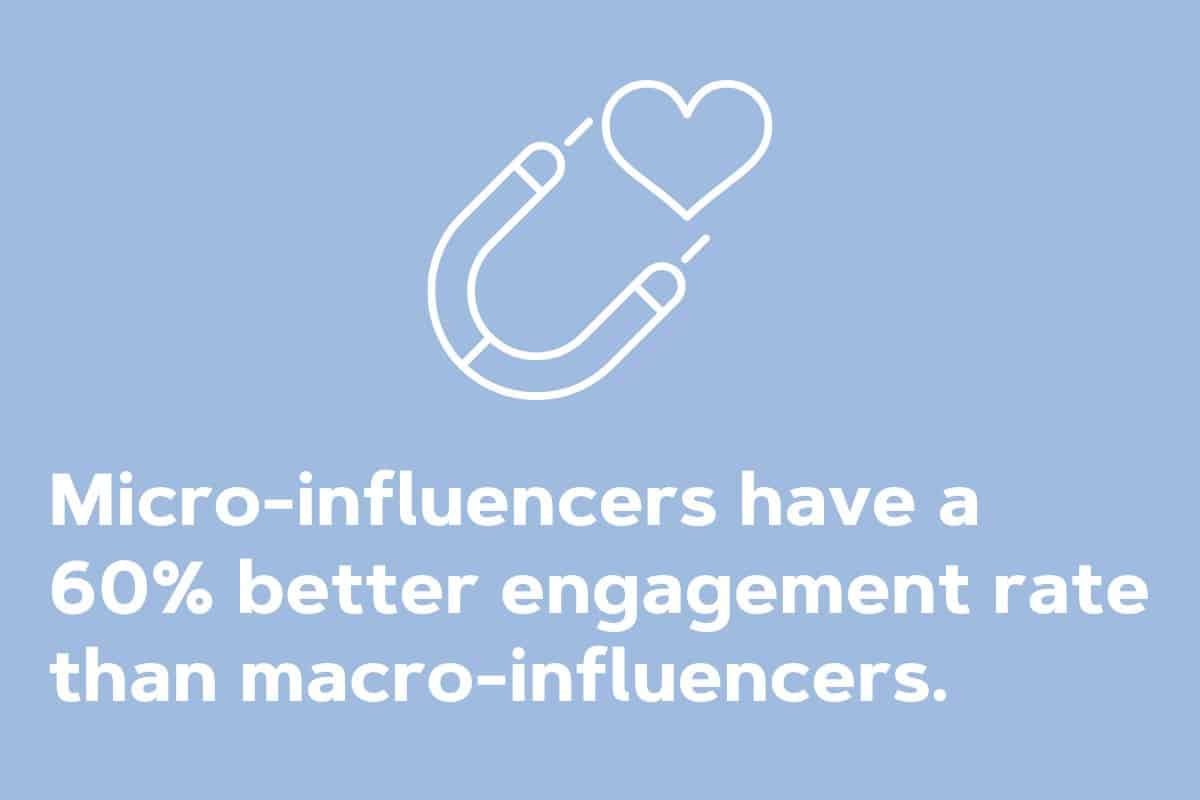
26. Micro-influencers have a 60% better engagement rate than macro-influencers
Do you want more engagement while spending less? Then you should find relevant micro-influencers because they can have a 60% better engagement rate than macro-influencers.
Note: An influencer’s engagement rate is best in the early 1,000s of followers but begins to plateau at around 100,000 followers.
Source: Emplifi
27. Micro-influencers have a 20%+ higher conversion rate
People who follow smaller influencers tend to trust them more than mega influencers or celebrity influencers. That’s why micro-influencers have one of the best and highest conversion rates at over 20%.
Source: Emplifi
28. 44% of marketers say one of the biggest benefits of working with micro-influencers is the cost
As I mentioned earlier, working with micro-influencers is the cheapest. And according to nearly 45% of marketers, they say that the lower rate is one of the biggest benefits why they prefer to work with smaller influencers.
Source: HubSpot
29. Over half of the marketers investing in influencer marketing work with micro-influencers
Not everyone can afford to pay the high cost of working with mega or celebrity influencers.
But that’s OK because working with micro-influencers can also generate a massive return on investment – and that’s why 56% of the marketers who invest in influencer marketing work with them.
Source: HubSpot
30. 53% of micro-influencers have never used paid promotions
In most cases, micro-influencers grow their following organically, which creates a solid follower base because people decide on their own to follow them and are not “forced” into it through paid promotions.
Thus, 53% of micro-influencers have never paid to promote a post. (But sometimes brands want that extra reach, so paying a micro-influencer to boost a post isn’t something new).
Source: Influencer Marketing Hub #2
Instagram Influencer Marketing Statistics
31. The influencer marketing market on IG is expected to grow to around $26 billion by 2025
Being the most popular social media platform for influencer marketing, it’s no wonder why it’s growing so fast. It was valued at approximately $13.8 billion in 2021 but is forecast to double by 2025.
Source: Statista #6
32. Instagram is the most preferred influencer marketing platform
Instagram is the leading and one of the fastest-growing social media platforms in terms of influencer marketing adoption, with over 72% of marketers using it for their influencer campaigns.
| Year | Share of respondents |
| 2025 | 84% |
| 2024 | 80% |
| 2023 | 76% |
| 2022 | 72% |
| 2021 | 67% |
| 2020 | 62% |
Source: Statista #7
33. There are 20+ million posts tagged #ad on Instagram in 2023
Instagram influencer marketing is growing FAST. Not long ago, only a few million posts were tagged with #ad.
However, at the time of writing this, Instagram shows that there are already more than twenty million posts with that hashtag. But there are probably many more because not everyone uses #ad in their promotional posts.
Source: Instagram
34. Lifestyle was the most popular category among Instagram influencers (2021)
Instagram is still, to this day, a lifestyle app, so it’s no wonder why the lifestyle category is/was the most popular among Instagram influencers, with a share of 13.8%, followed by beauty (8.6%).
Source: Statista #8
35. 4 in 5 brands use Instagram for influencer marketing
This is another proof that Instagram is the most preferred social media platform for influencer marketing campaigns since four out of five brands use it. 79% of brands consider it the most essential platform for promoting their products and services.
Source: Influencer Marketing Hub #2
To get more on IG, don’t miss reviewing our Instagram engagement rate statistics.
YouTube Influencer Marketing Statistics
36. 42% of marketers used YouTube for their influencer marketing campaigns in 2022
According to Statista, YouTube was the fourth most popular platform marketers used for their influencer marketing efforts in 2022.
Fun fact: In 2021, TikTok surpassed YouTube as an influencer marketing platform, but both are expected to grow in the coming years (with TikTok experiencing faster growth).
| Year | Share of respondents |
| 2025 | 46% |
| 2024 | 45% |
| 2023 | 44% |
| 2022 | 43% |
| 2021 | 41% |
| 2020 | 39% |
Source: Statista #7
37. YouTube influencer marketing spending in 2020 was around $6.6 billion
In 2019, the YouTube influencer market spending/size hit $5.5 billion, but it increased by over $1 billion in just one year. While we don’t have the latest numbers, it’s safe to say that the market has expanded by some additional billions today.
Source: Statista #9
38. YouTube’s micro-influencers also have a higher engagement rate than mega-influencers
The overall engagement rate on YouTube is relatively low, but micro-influencers (1.64%) still have a higher one than mega-influencers (0.37%).
Source: Influencer Marketing Hub #2

39. 60% of YouTube subscribers follow advice from their favorite creators over their favorite TV/movie celebrities
When it comes to getting advice on what to buy, 60% of YouTube subscribers follow the advice of their favorite YT creators over their favorite TV or movie personality/celebrity. That’s why investing in a celebrity influencer may not be the best strategy.
It’s also said that teenage YT subscribers relate to YT creators more than traditional celebrities. Times change.
Source: Influencer Marketing Hub #2
40. Nearly 60% of YouTube viewers are male
While the viewer’s gender depends on the YouTube channel, generally speaking, more males than females watch YT videos.
However, for the younger generation (13-24), 4% more females (26%) watch YT videos than males (22%).
Source: Influencer Marketing Hub #1
TikTok Influencer Marketing Statistics
41. 45% of marketers used TikTok for their influencer marketing campaigns in 2022
TikTok was the third most popular influencer marketing platform in 2022, with 45% of marketers using it for their campaigns. Note that TikTok is one of the fastest-growing platforms, as more and more marketers see massive potential in it.
| Year | Share of respondents |
| 2025 | 55% |
| 2024 | 52% |
| 2023 | 49% |
| 2022 | 46% |
| 2021 | 42% |
| 2020 | 36% |
Source: Statista #7
42. 72% of TikTok users say they relate to non-celebrity creators more than celebrity ones
A whopping 72% of TikTok users say they find ordinary, “normal” content creators more interesting than celebrities.
That’s why it’s essential to do extra research when it comes to finding influencers on TikTok and not just spend a big chunk of money on celebrities because the ordinary content creator can generate better results.
Source: TikTok #1
43. 80% of users say the platform helps them get ideas/discover brands and products they’d never thought of before
With so much content available on TikTok and a quick process of skimming through heaps of it, it’s no wonder why it helps 80% of users get new ideas and discover new brands and products they’d never thought of before (or find elsewhere).
Source: TikTok #1
44. 72% of TikTok users took off-platform action after watching a review from the creator they trust
Even though many users say it would be great to have purchasing options available on the platform, many don’t mind leaving the platform to take action.
In fact, over 70% of TikTok users report they made an off-platform action after watching a product review by a creator they trust.
What’s more, 92% said they felt a positive emotion that caused them to make an off-platform action.
Source: TikTok #2
45. 65% of TikTok users always rely on reviews and creator recommendations when deciding what to buy
This is a big one. 65% of TikTokers say they ALWAYS rely on online reviews and recommendations from their favorite creators when deciding what to buy.
In addition, 40% of users say that the number one motivating factor that makes them purchase is when creators “lift their spirits.”
Source: TikTok #2
Facebook Influencer Marketing Statistics
46. 55% of marketers used Facebook for their influencer marketing campaigns in 2022
At a share of 55% of marketers adopting Facebook for their influencer marketing efforts, it makes it the second largest platform, right after Instagram.
Facebook’s forecasted growth is steady by not as slow as YouTube’s.
| Year | Share of respondents |
| 2025 | 62% |
| 2024 | 61% |
| 2023 | 58% |
| 2022 | 55% |
| 2021 | 52% |
| 2020 | 48% |
Source: Statista #7
47. 60% of Facebook video views are from influencer videos
If you asked me how many video views influencers generate on Facebook, my guess would be way lower than 60%.
As a reference, media company videos are in second place with a 30% share, followed by brand (10%) and aggregator (10%) content.
Source: Statista #10
48. Facebook ads’ potential reach is 2.08 billion people
It’s no secret that Facebook is HUGE. And it’s also no secret that the potential people-reach on FB is huge. As the most popular social media platform in the world, Facebook advertisements have the potential to reach a staggering 2.08 billion people. (FB ads reach one-third of the global population over 13.)
Source: Hootsuite #1
49. 10% of influencers feel discrimination on Facebook
If you think discrimination is high on Facebook, think again – it’s actually the lowest. Most influencers named TikTok (58%) as the platform with the most discrimination, followed by YouTube (14%) and Instagram (13%).
Source: Influencer Marketing Hub #1
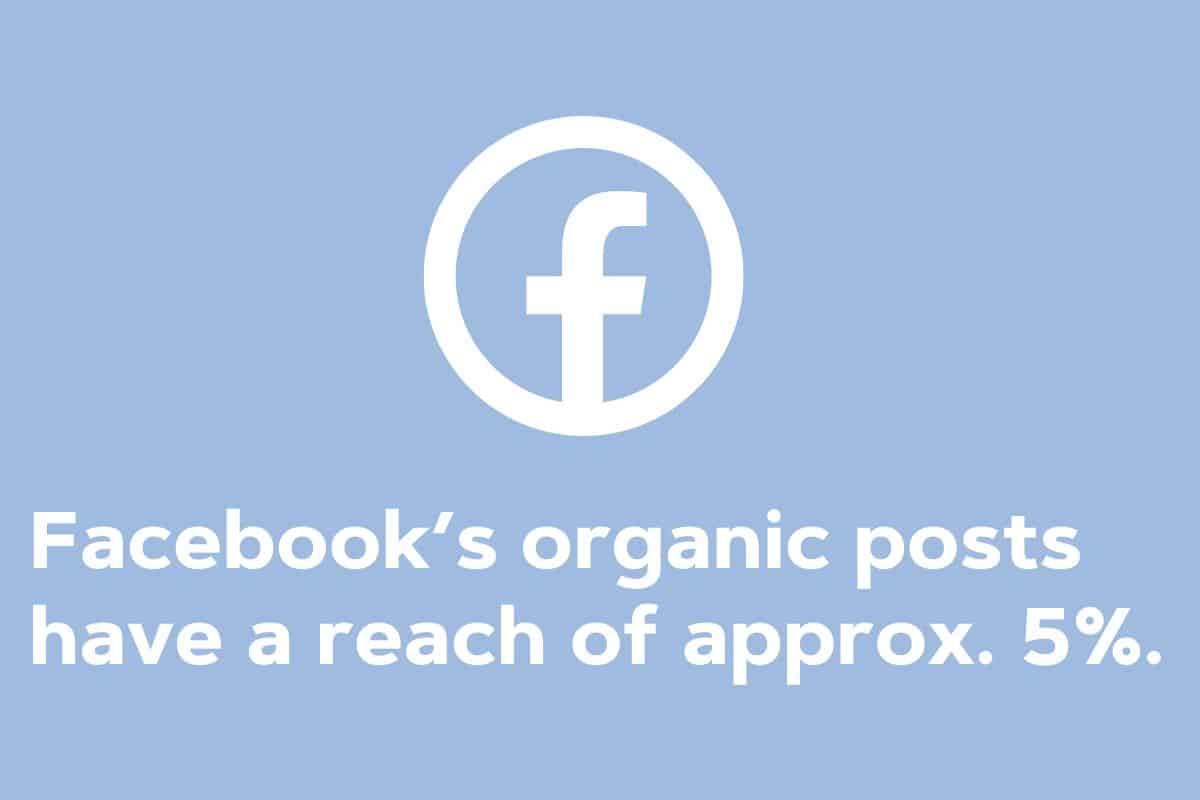
50. Facebook’s organic posts have a reach of approx. 5%
Yes, Facebook’s organic reach is declining; everyone who runs a FB page knows that. It was found that the average reach of an organic post on Facebook is around 5%.
Still, some pages receive a much better organic reach than others, but no matter how loyal your fans are, the reach is still declining.
Source: Hootsuite #2
Influencer Marketing Challenges Statistics
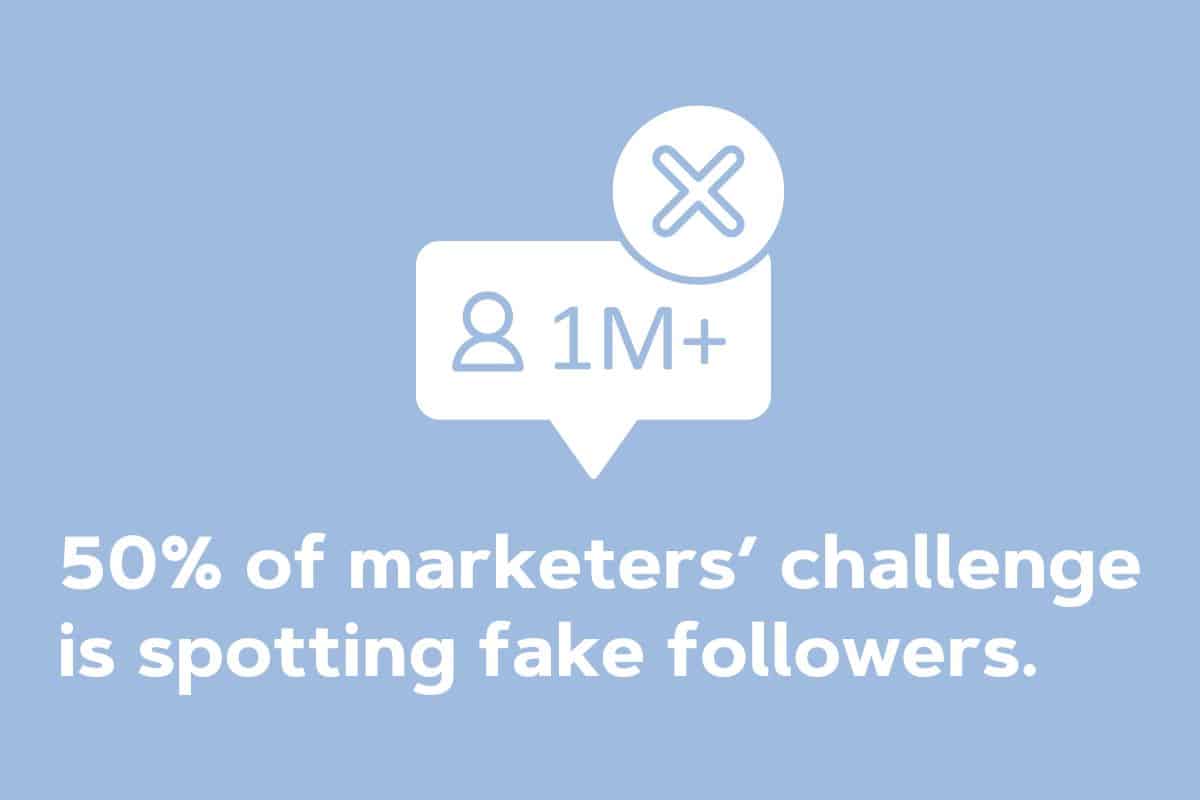
51. 50% of marketers’ biggest challenge is spotting fake followers
There are many challenges marketers who invest in influencer marketing face, but most report struggling with spotting fake profiles and inauthentic engagement.
| Challenge | Share of respondents |
| Spotting fake followers & inauthentic engagement | 50% |
| Social algorithm changes | 49% |
| Building a continuous strategy | 41% |
| Rising influencer costs | 38% |
| Keeping up with social media trends | 33% |
| Building a strong creative strategy | 33% |
| Reducing time spent managing campaigns | 30% |
| Brand safety/aligthnment | 28% |
| FTC regulations | 18% |
| Tapping into emerging channels (Twitch) | 17% |
| Moving influencer marketing in-house | 12% |
Source: Mediakix
52. Businesses have a hard time determining influencer marketing ROI
We already had a conversation on the return on investment of influencer marketing earlier, and while there are measurements for it, many businesses still find it challenging to determine it.
When there are tracking links involved, the measurement is much easier. But when it comes to brand awareness, measuring ROI becomes more complicated.
Moreover, over 28% of brands running in-house campaigns say measuring ROI and campaign results is their biggest challenge.
Source: Influencer Marketing Hub #2
53. 27% of businesses name “finding influencers” a challenge
While influencers are everywhere in the 1,000s for almost any industry, finding the right one for your exclusive campaign isn’t the easiest thing to do.
Thus, 27.4% of businesses report that their biggest challenge is finding the right influencers for their campaigns (up from 22% since 2021).
Source: Influencer Marketing Hub #2
54. Organic influencer marking can be very hit-and-miss (without tools)
When influencer marketing first started, the organic approach was extra challenging, especially because of the lack of available tools. But these days, many businesses use tools (in-house or 3rd-party), and 72% of the influencer marketing campaigns are run in-house.
On the contrary, many brands also work with agencies, particularly when seeking micro- and nano-influencers, because they are more experienced at spotting the right talent.
Source: Influencer Marketing Hub #1
Influencer Marketing Fraud Statistics
55. 55% of businesses have experienced influencer fraud
Even though it was expected that influencer fraud is declining, it’s actually up from 2022. Last year, 31% of respondents reported they got scammed, while in 2023, the number rose to 55%.
But this might be because businesses and agencies have become more experienced in spotting “fake influencers.”
Influencer Marketing Hub also reports that nearly 70% of brands are concerned about influencer fraud.
Source: Influencer Marketing Hub #1
56. 26% use influencer platforms to discover fraud and fake followers
If an influencer has a lot of followers, but their per-post engagement is poor, there’s likely something fishy about it.
However, only 26% of professionals use influencer platforms to discover and perform fraud and fake follower analysis.
Source: Influencer Marketing Hub #1
57. Nearly 50% of influencers are involved in fraud
Even though influencer fraud seems to be declining across the platforms, around 50% of the influencers (particularly mega-influencers) are still engaged in fraud.
66% of mega-influencers were involved in fraud in 2020 and approximately 4% less in 2021.
Source: Statista #11
58. Brands try to protect themselves by running in-house influencer campaigns
Not only do brands opt for running influencer campaigns in-house for better measurement of campaign effectiveness but also because they’re wary of fake influencers. Their trust in hiring an agency to do the job is low because (they think) they’re likely to fall for fake influencers.
Source: Influencer Marketing Hub #2
59. Fraudulent activity can cost brands $300 per post
Nobody wants to waste money, but it can happen when working with influencers both big and small.
The research found that posts from fraudulent influencers with 100,000+ followers can cost brands and marketers around $300 per post.
On the other side, the loss can be from $10 to $35 per post when working with micro-influencers. The latter might not be much, but it can quickly stack up and eat a large chunk of your marketing budget.
Source: Statusphere
Conclusion
As we conclude this exploration of influencer marketing stats, it becomes clear that the power of influential personalities extends far beyond merely social media presence.
The data shows the ability of influencers to drive brand awareness, foster authentic connections with consumers and – of course (!) – generate impressive returns on investment.
Brands and influencers alike can stay up to date with the latest trends and best practices to capitalize on this dynamic marketing approach.
By leveraging the insights gained from these statistics, marketers can craft strategic influencer campaigns that resonate with their target audiences and yield remarkable results.
GO!
Was this article helpful?
YesNo
این خبر را در ایران وب سازان مرجع وب و فناوری دنبال کنید